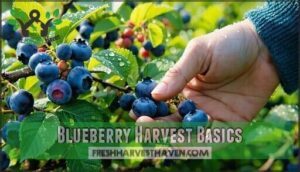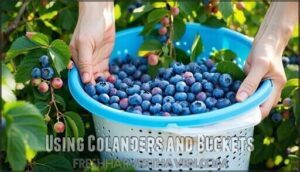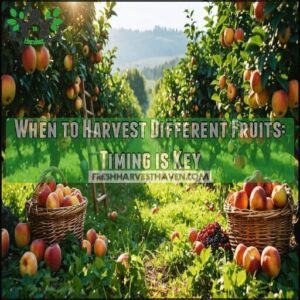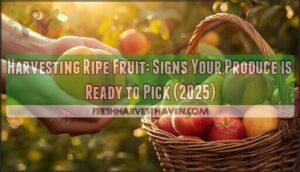This site is supported by our readers. We may earn a commission, at no cost to you, if you purchase through links.
 To harvest ripe blueberries, wait until they’re deep blue and release easily with a gentle touch.
To harvest ripe blueberries, wait until they’re deep blue and release easily with a gentle touch.
Ripe berries should feel slightly soft but not mushy, and they’ll detach from the stem without resistance.
Pick in the morning when temperatures are cooler to preserve freshness.
Use the "rolling" technique – gently cup clusters and let ripe berries fall into your palm while leaving unripe ones on the bush.
Avoid pulling or tugging, which can damage both fruit and plant.
Check bushes every few days since berries ripen gradually over several weeks.
The perfect berry practically jumps into your hand when you know what to look for, and it’s essential to handle them gently to preserve their freshness and avoid damaging the plant.
Table Of Contents
- Key Takeaways
- Blueberry Harvest Basics
- How to Harvest Ripe Blueberries
- Identifying Ripe Blueberries
- Harvesting Techniques and Tools
- Timing and Scheduling Harvests
- Frequently Asked Questions (FAQs)
- Should you pick blueberries as soon as they turn blue?
- How to harvest perfectly ripe blueberries?
- How do you harvest blueberry bushes?
- How do you ripen blueberries?
- Are ripe blueberries ready to be picked?
- Which Blueberry berries ripen best?
- Are blueberries ready for harvest?
- How long can ripe blueberries stay on the bush?
- How long does it take for blueberries to go from green to blue?
- What pests commonly attack ripening blueberries?
- Conclusion
Key Takeaways
- Wait for deep blue color with whitish bloom – Don’t pick berries as soon as they turn blue; wait until they’re completely deep blue with no pink tinge and detach easily from the stem for maximum sweetness.
- Use the gentle rolling technique – Cup clusters and roll ripe berries between your thumb and forefinger instead of pulling or tugging, which prevents damage to both fruit and plant.
- Harvest every 5-7 days during cool morning hours – Pick regularly since berries ripen gradually over several weeks, and morning temperatures help preserve freshness and firmness.
- Handle berries gently in shallow containers – Use shallow containers to prevent crushing, check harvested berries immediately, and separate any damaged ones to maintain quality.
Blueberry Harvest Basics
Getting the timing right for blueberry harvesting makes all the difference between sweet, juicy berries and disappointing sour ones.
You’ll need to understand how climate, variety, and ripening factors work together to determine when your berries are ready to pick.
Importance of Timing
When you nail harvest timing, you’ll gain optimal ripeness and maximize flavor in every berry.
Perfect timing means the difference between tart, disappointing fruit and sweet, juicy blueberries bursting with taste. Ripe blueberries develop their full sugar content only when left on the bush until completely mature.
Wait too long and berries burst with sweetness today, spoil tomorrow.
Pick too early, and you’ll reduce waste from inedible berries. Wait too long, and overripe fruit will spoil quickly.
The blueberry harvest window spans just 2-3 weeks, so monitoring your bushes daily helps extend yields throughout the season. Smart harvest timing prevents you from missing peak ripeness and helps you prevent spoilage by collecting berries at their absolute best.
To guarantee a successful harvest, consider assessing ripeness by color.
Factors Affecting Ripeness
Your blueberry ripeness depends on several key factors.
Perfect timing unlocks your blueberries’ sweetest potential—every factor matters for peak flavor.
Soil pH between 4.0-5.0 creates ideal conditions for sugar development, while sunlight exposure of 6+ hours daily accelerates ripening.
Variety type matters—some ripen faster than others.
Watering schedule affects sweetness; consistent moisture during fruit development is essential.
Pruning impact improves air circulation, promoting even ripening throughout your bushes.
Climate and Gardening Zone
Your local climate and gardening zone determine when your blueberry harvest begins. Understanding these factors helps you plan better picking schedules.
Regional Ripening patterns vary dramatically across the country. Northern growers in hardiness zones 3-5 typically harvest from July through August, while southern regions in zones 7-10 can start picking as early as late May. Your microclimate effects also matter – higher elevations delay ripening by about 10 days per 1,000 feet.
Zone-Specific Cultivars perform best when matched to your area’s conditions:
- Northern varieties like ‘Northland’ thrive in cooler climates
- Southern cultivars such as ‘Sharpblue’ handle heat better
- Local weather patterns influence daily ripening speed
- Season extension techniques can prolong harvest periods
- West Coast berries often ripen before East Coast varieties
Choose varieties suited to your gardening zone for ideal results.
How to Harvest Ripe Blueberries

Perfect timing makes all the difference when picking blueberries for maximum ripeness and berry sweetness.
Hand-picking guarantees you select only the ripest fruit while protecting your blueberry harvest from damage.
Follow these essential steps for successful harvesting:
- Cup your hand beneath berry clusters to catch falling fruit
- Roll each berry gently between thumb and forefinger instead of pulling
- Use shallow containers to prevent crushing during collection
- Check harvested berries immediately and separate any damaged ones
Your harvesting frequency should be every 5-7 days during peak season.
Pick during cool morning hours when berries are firmest.
This careful approach maximizes storage duration and guarantees proper post-harvest care for your ripe blueberries.
Identifying Ripe Blueberries
You’ll know your blueberries are ready when they develop a deep blue color with a slight whitish bloom on the surface.
The berries should feel plump and firm while detaching easily from the stem with just a gentle roll of your fingers, which indicates they are ready to be picked and used.
Color Indicators
The color progression tells you everything about blueberry ripeness. Watch berries transform from green to pink, then reddish-purple, and finally deep blue with a matte finish. Red tints mean wait longer—ripe blueberries show uniform color throughout.
Perfectly ripe
Pink varieties like ‘Pink Lemonade’ are different—they’re ripe when bright pink all over, and it’s time to Harvest now.
Texture and Softness
You can tell ripe blueberries by their texture.
They yield slightly to gentle pressure but aren’t mushy.
Here’s how to check firmness factors:
- Gentle squeeze test – Ripe berries give slightly like a small water balloon
- Softness stages – Avoid hard unripe berries and overly soft overripe ones
- Texture changes – Look for plump, juicy feel without mushiness
- Bruising prevention – Use light pressure when testing to avoid damage
This texture indicates perfect blueberry ripeness for harvesting.
Taste Test
When you’re unsure about those borderline berries, pop one in your mouth.
Ripe blueberries deliver unmistakable sweetness levels and juiciness that unripe ones can’t match.
A taste test reveals the truth about ripeness better than any visual cue.
Different varieties offer unique berry flavor profiles, but proper sweetness levels always indicate readiness for harvesting.
Tartness factors generally signal the berry needs more time on the bush.
Trust your ripeness perception.
Stem Attachment
One clear signal tells you when ripe blueberries are ready: detachment ease. When berries reach perfect ripeness, they’ll release with a gentle tug or gentle roll between your fingers.
No picking pressure needed – forced pulling means they’re not ready yet. The stem condition should show a clean, dry scar after berry separation, not a torn or wet mark.
This natural stem attachment release protects both your plump berries and the bush from damage. For successful growth, remember that blueberries often require hundreds of chilling hours.
Master this simple harvesting tip, and you’ll collect perfectly ripe fruit every time.
Harvesting Techniques and Tools
Once you’ve identified ripe blueberries, proper harvesting techniques protect both the fruit and the plant.
The right tools and gentle handling methods guarantee you’ll get the best quality berries while keeping your bushes healthy for future seasons, using gentle handling methods.
Hand-Picking Methods
Perfect berries deserve perfect picking techniques. Master these hand picking methods to protect your precious harvest.
The gentle rolling technique works like magic for ripe blueberries. Place your thumb and forefinger around each berry, then roll it away from the stem with minimal pressure. This prevents bruising while keeping your plants healthy for future harvests.
Here’s your foolproof approach for harvesting tips that work:
- Use basket use strategy – Keep a shallow container close to catch any dropped berries
- Focus on individual berries – Pick one at a time rather than grabbing handfuls
- Practice preventing bruising – Let gravity help by cupping your hand underneath
A gentle touch makes all the difference. For efficient harvesting, consider using a specialized picking container. When picking techniques feel natural, you’ll avoid damage while maximizing your harvest quality.
Using Colanders and Buckets
Your container material matters for successful harvesting. Choose plastic buckets with smooth interiors to prevent berry damage. Bucket size should allow single-layer collection without crushing.
Colander design with proper drainage holes enables simultaneous picking and cleaning. For all your needs, consider harvesting colander blueberries.
Line buckets with bags for easy transfer. Cleaning methods become effortless when colanders drain water while protecting ripe blueberries. These harvesting tips guarantee your delicate fruit stays intact from bush to table.
Avoiding Damage and Bruising
Blueberries are delicate fruits that require careful handling to prevent bruising and maintain quality.
Your gentle touch makes all the difference between perfect berries and damaged fruit.
Handle each berry like a soap bubble.
Use shallow containers to prevent crushing from weight.
Never grab handfuls or strip branches, as this damages both fruit and plant.
Here are three key strategies for damage-free harvesting:
- Gentle Handling – Roll ripe blueberries off stems with your thumb, letting them fall softly into your palm
- Container Choice – Use shallow containers or colanders to minimize drops and prevent berry crushing
- Layering Berries – Keep containers only partially filled and arrange fruit in single layers for protection
Temperature control helps too.
Handpicking during cool morning hours reduces bruising risk and maintains firmness.
Post-Harvest Handling
After harvesting, proper handling maintains your blueberries’ quality and extends their shelf life. Rinse berries gently under cold water, then air-dry completely before storage.
Gentle handling techniques are vital to preventing bruising and maintaining fruit integrity.
| Storage Method | Container Type | Shelf Life |
|---|---|---|
| Refrigeration Methods | Breathable containers | 1 week |
| Freezing Techniques | Airtight bags | 1-2 years |
| Drying Blueberries | Sealed jars | 6 months |
For berry storage, use breathable containers in the refrigerator. When berry freezing, spread berries on trays first to prevent clumping. Berry washing right before consumption timing guarantees the best freshness and flavor.
Timing and Scheduling Harvests
Knowing when to harvest your blueberries makes the difference between sweet, juicy berries and sour disappointments. The timing depends on your location, variety, and daily weather patterns.
Hardiness Zones and Seasons
Your gardening zone shapes your blueberry harvest timeline. Zone Suitability determines when berries ripen, with Regional Variations creating unique Seasonal Impact patterns. Climate Influence and Microclimates fine-tune timing within your area.
Consider how weather impacts fruit quality during harvest.
Here’s what makes each hardiness zones special:
- Zone 3-4: Late summer rewards for patient gardeners
- Zone 5-6: Perfect balance of warmth and coolness
- Zone 7-8: Early blueberry season brings quick satisfaction
- Zone 9-10: Extended picking periods maximize your harvest
- Cold pockets: Unexpected delays that test your timing
Understanding your blueberry harvest season helps you plan picking schedules effectively.
Variety-Specific Harvest Times
Your blueberry harvest success depends on choosing the right varieties for extended harvests. Early-Season Varieties like Duke and Patriot ripen in late May through early June, giving you the season’s first sweet rewards.
Mid-Season Varieties such as Bluecrop and Blueray peak during July, providing consistent ripe blueberries for weeks.
Late-Season Varieties like Elliott extend your blueberry harvest into August and September.
Regional Variations affect harvest timing – southern gardens enjoy earlier ripening times while northern areas wait longer.
Plant multiple varieties for variety-specific harvest times that keep your berry bowl full all summer long.
Morning and Evening Harvests
When cooler temperatures prevail during morning harvests, you’ll discover optimal sweetness and berry firmness that translates to reduced bruising.
Evening harvests offer similar temperature effects on fruit ripeness, though pest activity increases after dark.
Both timing options protect your berries from harsh midday weather, ensuring you capture peak flavor and quality.
Weather Conditions and Harvesting
Weather patterns determine your harvest success. Rainy harvest conditions soften berries quickly, while heat effects accelerate ripening. Frost impact can damage tender fruit overnight.
Smart harvesting means reading the sky:
- Wait for berries to dry after rain to prevent mold
- Beat afternoon heat effects with morning harvests for better berry flavor
- Avoid windy days to prevent wind damage to delicate ripe blueberries
Frequently Asked Questions (FAQs)
Should you pick blueberries as soon as they turn blue?
Like a painter waiting for the perfect sunset, patience yields the sweetest reward.
Don’t pick blueberries immediately when they turn blue. Wait ten more days until they’re deep blue with no pink tinge and detach easily from the stem, for this wait ensures they are perfectly ripe.
How to harvest perfectly ripe blueberries?
Wait until berries turn deep blue with a whitish bloom and detach easily when gently rolled between your fingers.
Harvest in cool morning hours, picking every 5-7 days during peak season.
How do you harvest blueberry bushes?
Gently grasp ripe blueberries and roll them off stems with your thumb and forefinger.
They’ll detach easily when ready.
Pick every few days during peak season, using shallow containers to prevent crushing the delicate fruit.
How do you ripen blueberries?
You can’t ripen blueberries after picking them. They must ripen naturally on the bush, turning from green to deep blue. Pick only fully ripe berries for sweetness.
Are ripe blueberries ready to be picked?
Yes, ripe blueberries are ready to pick! Deep blue color signals sweetness, firm texture promises flavor, and easy detachment from stems confirms perfect timing for harvest.
Which Blueberry berries ripen best?
All blueberry varieties ripen when they turn deep blue with a whitish bloom and detach easily from the stem.
You’ll get the best flavor and sweetness by waiting for this full ripeness.
Are blueberries ready for harvest?
Picture yourself as a blueberry detective, searching for the perfect deep blue suspects.
Check if your berries are completely blue with no pink or red tint near the stem.
They should detach easily when gently rolled between your fingers and feel firm yet soft.
How long can ripe blueberries stay on the bush?
Don’t let ripe blueberries linger more than a week on the bush. They’ll become overripe, soft, and shriveled, losing their perfect texture and sweetness you’ve worked hard to achieve.
How long does it take for blueberries to go from green to blue?
Green blueberries typically take 2-3 weeks to ripen into deep blue berries. They’ll progress through pink and light blue stages before reaching full ripeness. Weather conditions and variety affect timing.
What pests commonly attack ripening blueberries?
Just as luck would have it, right when berries turn their sweetest, hungry birds and bugs arrive for the feast.
You’ll battle birds primarily, alongside beetle larvae, aphids, and mites targeting your precious crop.
Protecting your crop may require installing bird netting to keep them safe.
Conclusion
Success in how to harvest ripe blueberries is like finding treasure in your backyard.
You’ll know you’ve mastered the art when berries fall effortlessly into your hand with the gentlest touch.
Remember to check your bushes every few days during peak season.
The rolling technique prevents damage while maximizing your harvest.
With proper timing and gentle handling, you’ll enjoy weeks of perfect berries.
Your patience and careful approach will reward you with the sweetest, most flavorful blueberries possible.












